Ijraset Journal For Research in Applied Science and Engineering Technology
- Home / Ijraset
- On This Page
- Abstract
- Introduction
- Conclusion
- References
- Copyright
Sustainable Fashion: A Study among Millennials
Authors: Vedansh Pareek, Vineet Kumar, Zidan Moosa, Dr. J. Krithika
DOI Link: https://doi.org/10.22214/ijraset.2023.56236
Certificate: View Certificate
Abstract
This research was conducted based on the thorough study of various authors, specialists, and innovators’ articles, research, and speeches. It took into consideration all the conditions that take place in the work environment and how changes occur. We did a literature review that gives an in-depth knowledge of how sustainability is all set to be a big and needed change for the present and future. Research Implications - To build data validity and accessibility, the exploration proposes utilizing eco-marks that are needed to be normalized in the design business. Also, a feasible design ought to be made at a much reasonable cost rather than simply taking a gander at it at another market of benefits making. The questionnaire gave an insight into the way consumers perceive the sustainable fashion industry. There are a huge proportion of consumers who still are doubtful to make a switch or to accept the new conception of this fashion. There is still progressive news that there is a widespread acknowledgment of sustainable fashion among the majority of consumers. The way the new consumers are approached, included, and delivered the product and the information plays a vital role.
Introduction
I. INTRODUCTION
Sustainability is a term which was coined in German, by Hans Carl von Carlowitz, in his Sylviculture economics in 1713. Since then, a lot of people have been working constantly to put more value and factors into it. Sustainability in simple terms is making sure that we use the resources available to us for our needs in a way that it lasts for future generations and does not harm the environment.
For a person who isn’t really aware of the terminologies like sustainability, ethical and slow fashion, he or she might wonder how it is all related to the environment and how does this impact it on such a wide scale that there is a need to change the way the fashion industry works. For seeing such answers and changes there is certain information and knowledge which we need to have. Here, in this research paper, we are trying to put it all together and highlight how the fashion industry has a dominant role in the impact on the environment.
Global fashion has seen a lot of criticism when it comes to causing irreversible harm to the environment. A recent study published in Nature Reviews Earth and Environment, which was done in April 2020 states the annual impact from the fashion industry is over 92 million tons of waste, 79 trillion liters of water consumption alongside chemical pollution and CO2 emission. Behind the flashy lights of the high-end stores, there are many environmental costs that tend to get ignored. Bygone those days when clothes were handmade, and fashion was for the riches. With the improvisation of mechanics of the industry, manufacturing clothes became faster and cheaper, and fashion has been introduced to the masses.
A. Scope of Sustainable Fashion
Sustainable fashion aims to reduce the impact on the environment from materials used for apparel, including the source of materials and the production process of clothing. There are many different aspects of sustainable materials and many ways to obtain a more sustainable industry. Now the question arises how do we produce a cloth which is sustainable, recyclable, and environment friendly? The answer is using sustainable fabrics which come in different kinds. There are many different sectors within the industry, and the production of clothing covers two important parts: the textile industry and the fashion industry. The textile industry means from plant/tree/animal/raw material to fabric, whereas the fashion industry covers the process from fabric to garment.
It is important to understand this difference and to take into consideration that every piece of clothing undergoes at least two different processes before it becomes a garment: from resource to material, and from material to end-product. Within the textile industry (the production of fibers and fabric), you can divide different types of fabric into two different categories: synthetic fibers and natural fibers. The most importantly synthetic fibers are polyester and rayon. Natural fibers can be plant-based (cotton, linen, hemp, bamboo) or animal-based (different types of wool or silk).
B. Current Structure of Market-Market Synopsis
The global sustainable fabric market was valued at USD 58.3 billion in 2018 and is expected to grow at a CAGR of 11.4% during the forecast period. The textile industry has a very negative impact on the environment. In pursuit of profits, manufacturers are producing larger volumes of textiles at a very fast pace. Polyester fabrics, which are currently dominating the textile industry, are found in 60% of clothing due to their superior stretchiness, durability, and comfort. However, this fabric has its origin from crude oil, which means every wash of polyester fabric release plastic microfiber into waterways, and these persist indefinitely, contaminating lakes & oceans, getting ingested by animals, and indirectly by humans. The landfills are also bursting with textiles waste, which is further creating havoc on the environment. Thus, to reduce the environmental impact of fabrics, sustainable fabrics are given consideration by researchers, textiles manufacturers, and also end-users.
II. LITERATURE REVIEW
While individuals all throughout the world are worried about the climate, contamination, and wastage, their help for supportable design will in general fluctuate. Higher pay gatherings and more incessant customers in the review would, in general, be stronger of economical style across all urban communities, with youngsters - particularly those matured 18-24-the steadiest of feasible design. Potential opportunities to support economic style incorporate giving serious marking or other data about the supportability of a design item, which could urge individuals to focus closer on its natural impression. Organizations could likewise be urged to characterize their brands as supportable brands that individuals can trust, rather than having customers center around individual items.As per Jennifer Farley Gordon, the Human effect on the climate has been a wellspring of serious feelings and discussions for almost fifty years. As contamination spreads and normal assets reduce, many individuals are turning out to be progressively aware of the unfavorable impacts on their wellbeing and prosperity. Current drives by different ventures to stop, decrease and fix the harm being done to the climate are not simply scrupulous, they are vital.The fashion industry has gotten no little proportion of analysis for its ecologically dangerous practices
The fashion industry utilizes more than forty million individuals, making it probably the biggest business on the planet just as one of the planet's greatest polluters. As the outcomes of human effect on the climate keep on interesting interests and mix debate, the style business is going under progressively extraordinary investigation. Likewise, maintainable style is a developing subject important to a wide scope of individuals, including preservationists, design understudies, and reliable customers. The speeding up of the style cycle is altogether changing how attire is esteemed. For instance, due to the common pattern for expendable "quick design," large numbers of the present cheap styles are disposed of subsequent to being worn only a small bunch of times. The quick design cycle has become so settled that many keep thinking about whether it is on a very basic level conceivable to change examples of utilization. Conversely, "slow style" could give an impressive advantage to the climate. In any case, modifying the manner in which we burn-through style may not be without negative implications: across the globe, a large number of vocations rely on the consistency of progress in design.These difficulties, a considerable lot of which have existed for longer than a century, won't be effectively or immediately addressed. The fashion industry is one of the most contaminating ventures on the planet. Settling on a cognizant choice to shop with reasonable brands can truly have an effect on the planet and individuals inside it. Individuals today are investigating the food they burn through and the synthetics they put into their bodies, they are additionally moving their buying choices to establish a cleaner climate through the garments they wear.
Here are a few motivations behind why you should make the shift to maintainable design.
- Sustainable brands center around quality, utilizing materials and completions that are made to endure just as being benevolent to the climate.
- Fast design is about patterns; however, we've been determined what to wear for such a long time that a significant number of us have failed to remember what our own exceptional style resembles. Numerous economical brands center around making immortal bits of top-caliber. Minister your very own style, bid farewell to cash squandering style, and wear garments that reflect you.
- The quick design industry leaves behind an immense ecological impression. Any reasonable person would agree the quick design is a genuine issue for the climate. In picking a reasonable design you can deny supporting the negative natural effect that the style business is causing, and thusly diminish your own ecological impression.
- By changing to morally made brands you are guaranteeing that the apparel you decide to spend your cash on hasn't exploited specialists or utilized kid work.
As per Fashion blogger named Georgia Weston Fashion has been persistently developing, regardless of whether as far as new plans by top brands or changing the style inclinations of clients. The manageable design has arisen as one of the striking patterns as of late, which is changing the manner in which individuals and brands see the style. Simply think about the number and assortment of garments a normal lady abiding in the city wears in a day. Beginning from joggers and pullovers for her morning activity to jeans and shirts for work alongside heels, there are numerous compulsory increments to closets. Indeed, even a modest shirt that you buy to wear somewhere around 10 to multiple times prior to discarding it has a monstrous natural impression.
Economical Fashion is a Recommended Choice!
Creating a modest shirt requires water, texture, and laborers battling to make the shirt in outrageous working conditions. Moreover, you ought to likewise consider the weight of the ranchers developing cotton and different laborers engaged with the inventory network. You likewise increment the weight on the climate by discarding the modest shirt into landfills. This is only one fundamental model. Presently envision individuals from everywhere the world buy garments lasting through the year and discard them off. A seriously enormous natural impression, right?
This is the place where the idea of feasible style comes into question. Supportability essentially alludes to the idea of staying away from the consumption of regular assets for keeping up with balance in the climate. In the space of design, maintainability focuses on the development of pieces of clothing with explicit thoughtfulness regarding natural elements.
So, what are the important factors which may dictate sustainability in fashion? Water consumption and contamination during the assembly and washing of garments. High energy use in producing synthetic fabrics ends up in elevated energy emissions.Increased usage of chemicals like pesticides and fertilizers within the production of raw materials like cotton. Massive levels of waste creation because of incineration of textiles and landfills. All of those concerns can have a large influence on our future generations. Therefore, it's important to reflect on the meaning and potential of the sustainability of fashion. you wish to be told a way to shop sustainably with an awareness of best practices like purchasing vintage clothes.
Let’s picture the daily routine of a mean city dweller. She wakes up groggily to place on a pair of joggers, shirt and heads to the gym. Then, she hurries back home, puts on a pant, a blouse, and a coat, struggles to decide between her multiple heels and heads to figure. Leaves add time for the Friday get-together, puts on a dress, fixes her makeup, and heads out. The clock strikes twelve, the carriage turns into a pumpkin, and he or she is back in her PJs. In the minimalist example above, you'll observe the sheer number of garments someone wears every day. While one may consciously use transport and take an eco-friendly bag to induce groceries, the sheer number of garments that are used and consequently the pollution caused goes unnoticed.
Yes, you cannot wear your gym clothes to work! But thought must be given to developing a sustainable closet. A cheap t-shirt that you just bought is going to be worn a maximum of 20 times and find yourself in an exceeding landfill. One can argue that it absolutely was well worth the money. But who pays the worth for the liters of water used, the non-biodegradable fabric releasing methane gas, underpaid workers struggling in sweatshops? Popular brands outsource their garment units to countries like Bangladesh and Vietnam where workers are paid bare minimum wages in inhumane working conditions to maximize profits.
Sustainable fashion may be a paradigm shift from the fast-fashion business, choosing natural and biodegradable fabric, reusing and upcycling clothes, consciously choosing brands that pay fair wages to farmers and workers alike.Sustainable fashion is not any longer a choice and conscious consumerism must become the new normal. According to Misha, an Indian citizen who is an experienced fashion retail manager, sustainable fashion is an enterprise platform that may still develop and innovate. It cannot only follow the trend but even be at the forefront of the industry within the fierce market competition.Taking clothing as an example, a series of issues like clothing fabric selection, price, and quality, after-sales service, etc. should follow the concept of sustainable development. in addition, fashionable design is additionally a vital marketing idea for sustainable development. If I select to shop for sustainable fashion, then they supply products that I can afford and are of reliable quality, and that they are service providers that may function long-term choices. From the aesthetic point of view of the figure, their design is additionally comfortable and sturdy.
According to authors Alison Gwilt & Timo Rissanen,Shaping Sustainable Fashion explores the problems of fashion, sustainability, and specifically the way within which fashion clothing is produced, used, and discarded. Today the style industry relies on the fast and efficient manufacture of the latest seasonal trend-driven products for an identified consumer in an exceedingly competitive marketplace. The continued cycle of shopping for, using, and putting off fashion clothing is predicated upon a system of production that has serious consequences for our society and also the environment.The trend for fast fashion has generated an exponential rise within the sale of fashion garments that are often worn deficient, washed too often, and quickly become discarded, while this trend is often related to garments available within the street, it seems that in the least levels of the style industry there continues to be a spotlight on the assembly of market-driven and disposable goods.
The author’s intention of this publication is to highlight a multiplicity of sustainable strategies that are being employed to scale back the textile waste generated during the manufacture and use of fashion clothing.So through all of these, we should understand that Fashion may be a part of life that must be sorted rather like the other phase. Your fashion style tells plenty about your personality and you like someone. With major shifts within the industry of fashion, we are grateful for this one incontrovertible fact that now we will opt from various trends and own what we like. But because the fashion movement is rushing forward, people have become choosy and also prefer fast fashion over everything. They fail to comprehend how briskly fashion is probably light on pockets but is harmful to the environment in the longer run. Consumers’ awareness of sustainability, regarding environmental pollution, is increasing. As a way to promote sustainability, developing a sustainable supply chain is an important strategy for many fashion companies. As consumers, we are by no means perfect and we shouldn’t be expected to be, however, we need to realize that it is us that hold the power to bring about change.
To hold corporations accountable and to apply pressure to bring in positive changes and give credit where it is due, which starts with treating their own workers ethically. It’s unrealistic to believe that all of us can go from purchasing fast fashion one day to only thrifting the next; there are far too many factors that go into it and for many, thrifting may even be a privilege. But the only way to progress is by making little improvements where possible for each of us as individuals because those little changes will add up and contribute to making this better for our own futures.Although literature review and case studies help the industrialists to better develop a sustainable fashion supply chain, there are several limitations in this paper. Feasible style is a thriving area of the fashion industry with the possibility to develop as customers become more educated regarding the dishonest treatment of laborers and environmentally ecologically depleting practices of the quick fashion industry. By slowing down utilization and creating designs, the fashion industry can be made more practical for what's to come.To accomplish the outcomes the development wants, buyers should be confronted with the acknowledgment that the non-straightforward, quick design goliaths they effectively prefer are not making a positive social or ecological effect. Alongside more educated buyers, organizations should create diverse showcasing approaches that go past catchphrases like "green" or "eco-accommodating" and allure clients towards their item quality, solace, and brand name.Sustainable fashion could potentially change the way people consume and the way companies produce, with the correct balance of the two, incredibly positive socially and environmentally beneficial effects would ensue.
III. RESEARCH METHODOLOGY
A. Objective of the Study
The objective of the study here is to thoroughly understand what lies in the future for sustainable fashion. It gives us a brief insight of what the present technology is capable of providing and how well are consumers versed with the concept.
The research helps us understand the mindset of consumers and the positive impact of making a switch to sustainability. It also gives us knowledge on how good quality products can be achieved in a harmless manner with green economy.
B. Scope of the Study
A definitive objective of the feasible design development is to enormously dial back creation and utilization of articles of clothing on the worldwide scale (Flower, 2009).
The vital part of economical creation is the 'supplanting of hurtful synthetic compounds with harmless to the ecosystem materials' as well as the decrease of 'waste and asset utilization through clothing reusing' (Flower, 2009). To completely grasp the progressions that manageable design recommends giving a rule to moral creation and consumption is essential.
Three pivotal components are important to energize the development of supportable design: the first is to 'move purchasers' mentalities from amount to quality by empowering individuals to purchase top notch things now and again'; the second is work with creation that "doesn't take advantage of regular and HR to facilitate fabricating speed;' and the third is to utilize utilization to "involve a more extended item life expectancy from assembling to disposing of" (Jung et al, 2014).
Scholastic comprehension of slow style is at present restricted, but with the development of additional feasible organizations and customer interest there is trust that reasonable design will be incorporated in the near future.
There are numerous constructive outcomes of embracing a more maintainable design framework and instructed buyers are figuring out how to settle on more socially cognizant buying choices. Without a perspective it is hard to qualify the momentum connection among buyers and manageable brands; the examination that has been done as such far, in any case, gives a structure that could be utilized to increment purchaser comprehension of the adverse consequences of quick design, and the chance of the improvement of a maintainable attire model.
IV. ANALYSIS AND INTERPRETATION
There’s a lot of research and feedback done and taken in order to make decisions towards any impactful change implied. The above paragraphs correctly tell all the factors that impact the choice of a consumer. Media, advertisement, feedback from fellow consumers, company's reputation and its public relations all goes hand in hand in making a consumer shift from a particular habit to another revolutionary one.Keeping all the previous details in mind, we can go ahead and understand this whole sustainable concept practically. A questionnaire was put out to an open audience which asked them questions about their buying habits, their awareness of the sustainable and ethical manufacturing concept. The questions were basic and one which most of them could answer with personal experience so that we get authentic primary data. The conclusions drawn from the sample of this is stated here as well with the pie diagrams.From the questionnaire put out, we could see the ratio of the open audience. Most of our respondents are between the age 20-3
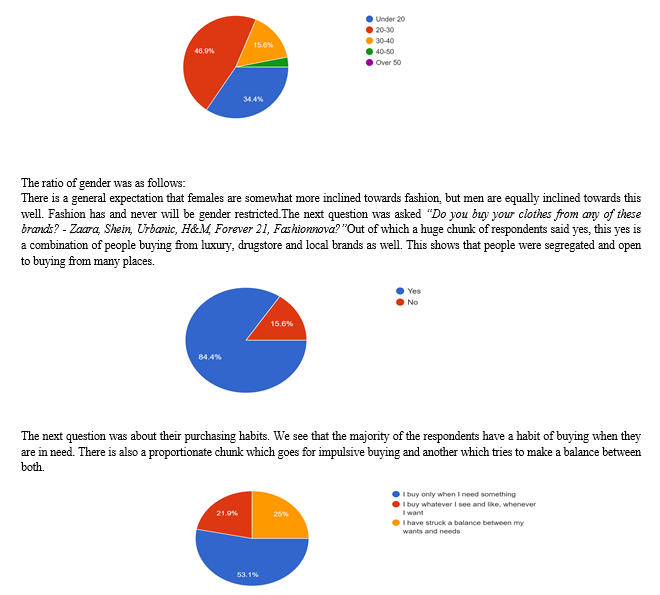

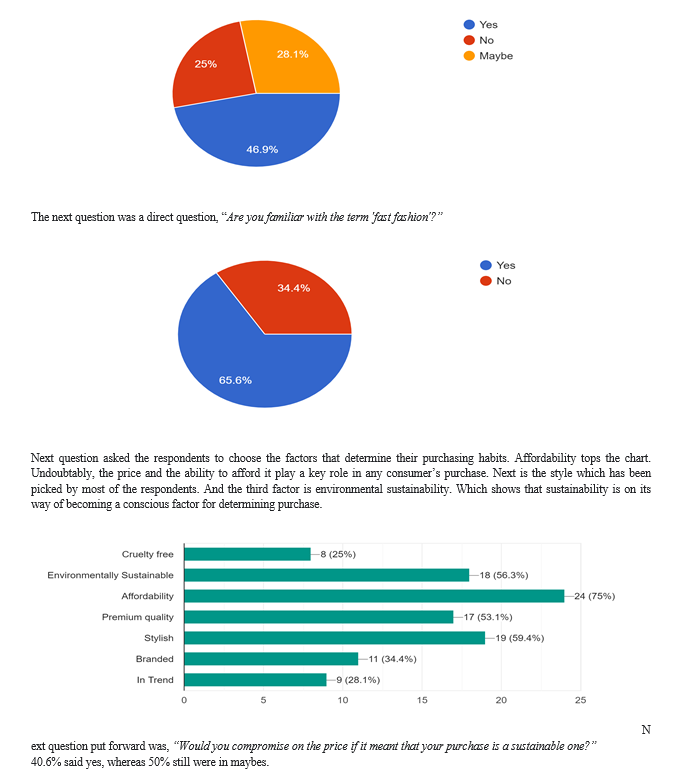
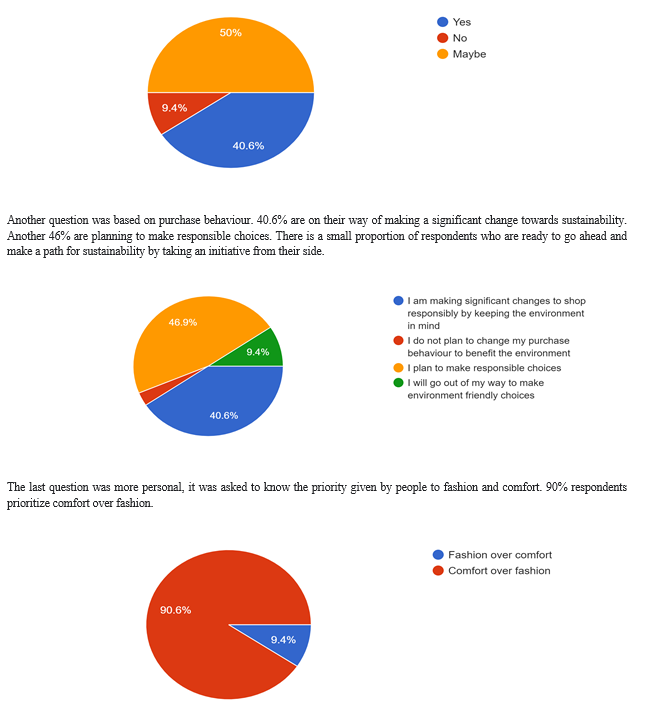
The following sample gave us a sneak peak into consumers' minds about their view on sustainability and their purchasing ways. This helps us to know the areas where we can improvise and put emphasis if we want to go ahead with sustainable fashion. The consumers need to be aware of the need and ways of the shift they are making before being asked to do so.
The fast-growing fashion industry has connected modern young women of all walks of life-economic backgrounds. Technology plays a mighty role in consumers of fast fashion’ ethics and loyalty to retailers. Today's technology allows consumers to access the great amount of information available surrounding the latest styles or trends. Lots of fast fashion consumers are interested in celebrity culture and high fashion and want to buy the same things. The difficulty lies in the fact that these consumers want what they see these social figures dress or styles emerging from the main runway fashion shows right away, however they can't afford these things. Use of Fast fashion reflects the public's desire for the identity of the people who set social standards and aspirations.One fast fashion fanatic and fashion design student explains what she sees when she goes to the store, "I want to see new things and styles that help me create and renovate my wardrobe and who I am. But I don’t want to look like someone else — so the seasonal editions that come out need to satisfy my need for diversity. I don't have a fixed aesthetic and I do not like dressing mainstream. However, to be fashionable one must inevitably follow trends, and so I do the same.
But I always give it my own twist, so as to not look basic. Designers these days are very open minded with their work. They are bold and are not afraid to work with strange concepts. And as an aspiring designer myself, I am in awe with their original work, and I believe I must keep up with it through my own style and dressing. When I see it on catwalks or in magazines, I want it right away.Since I can't afford it, I have no choice other than indulging in purchasing from Fast Fashion stores that mimic catwalk designs. While this has been going on for a while, I've slowly discovered the joy of shopping from local brands, original creators and thrift shopping. It has been wonderful! I am trying to curb my fast fashion purchases bit by bit. Slowly but surely, I will indulge completely in slow/ethical fashion." (Khatija Rumaan, B.Des, MAHE 2019-2022). It is important to understand that consumers particular to the fast-paced fashion industry, want their fashion articles to reach them quickly. As a result, fast fashion companies are exerting pressure on supply chain lead time. This preference of consumers and the need for immediate supply also ultimately results in a cheaper product.
Fast fashion products life span can be valued at the rate it deteriorates for the first time after a number of washes. Lots of fast-moving fashion companies obviously state that the products will last about ten cleanses after which the product will start deterioration due to substandard materials and later producing something they do not say. In addition, this makes products to be discarded easily because styles and trends change quickly. And buyers will always shop at the store that offers them their products with the fastest method and cheapest price.
We came across one such personality, who has been advocating a sustainable lifestyle for quite some time and has deeply impacted the masses.
V. CORRELATION ANALYSIS
A. Age & Gender in terms of their Attitudes Towards Sustainable Fashion
Setting up hypothesis:
H1o: There is no relationship between the Age & Gender in terms of their attitudes towards sustainable fashion.
H1a: There is a relationship between the age and Gender in terms of their attitudes towards sustainable fashion.

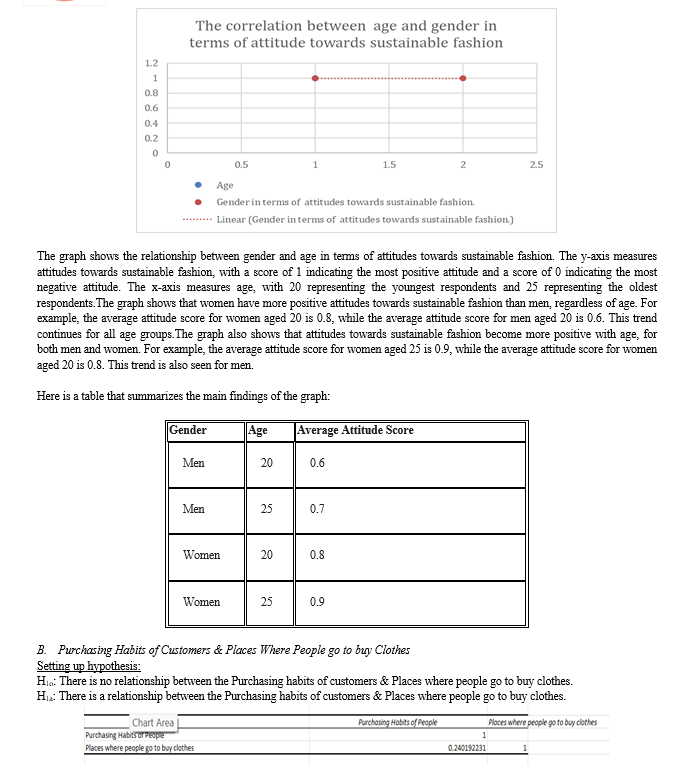


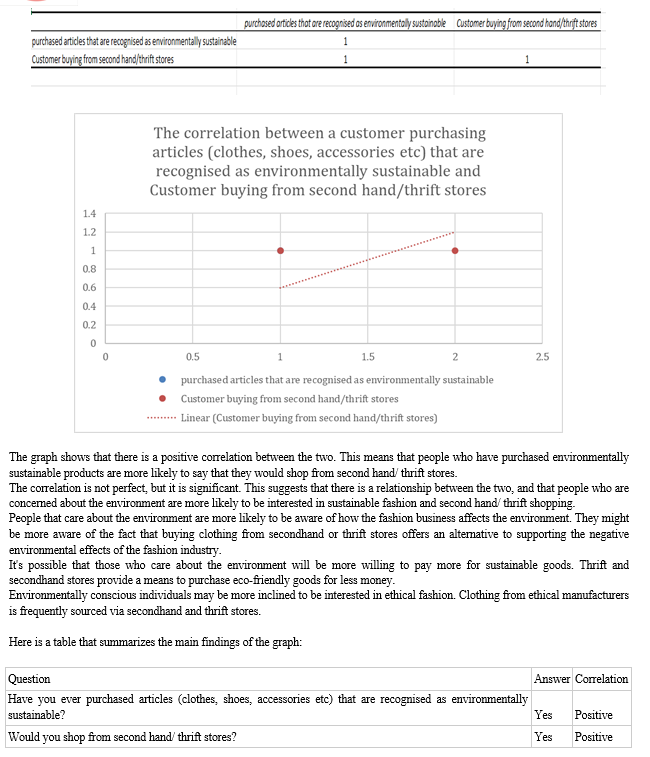
VI. FINDINGS
The research demonstrates that customers are more able to exchange utilized garments when they have higher remaining qualities and exchanged utilized garments can be considered as a benefit inspiration instead of an ecological inspiration. Customers' reusing choices depend on their worth constructions; nonetheless, those shoppers with all the more earth mindfulness are bound to utilize other chief reusing choices as opposed to exchanging straightforwardly to noble cause shops.
Moreover, expanding comfort of reusing choices would not prompt an increase in using exchanging alternatives; since eco-accommodating customers are keen on utilizing other chief reusing alternatives that require more work as per their capacities, like change. Customers buy garments with higher frequencies; they are more delicate to style patterns and more intrigued by redesigning used garments for re-utilizing.
There are two answers for expanding the redesigning rate i.e., expanding the information dependability and presenting a redesign solution package. Information from the right resources could urge customers to be all the more harmless to the ecosystem, as customers with more ecological knowledge and information on being harmless to the ecosystem are more able to utilize a redesign solution plan to change used garments.
The economic crisis could diminish customer uses on green garments. Design shoppers with higher buying frequencies are affected by the emergency, as their uses have diminished. Respondents, who have more worries about being harmless to the ecosystem, are fundamentally more influenced by the financial emergency when buying green items.
VII. LIMITATIONS
A few studies have proposed that reuse practices don't really prompt buying conduct, for example, a person who reuses paper yet doesn't accept reused paper items. Various examinations likewise have discovered just a frail connection between natural concern and the decision of green items. Furthermore, shopper mentality toward the notice can be affected by the variables, including item bundle and advancement strategies. For instance, utilizing reused materials for promoting, for example, reused paper or reused texture for design and expendable duplicates will help develop purchasers' trust, information, and certainty.
Our research is subject to certain fundamental research boundaries as well. Due to the use of digital tools and secondary research, the study couldn't be conducted in depth of the concept. The sample used to carry out the research was forced to focus only on Generation Z since that part of the population is aware of the concept hence limiting the perspectives and participation of older generations. However, the choice of our sample fitters it down to relevant information and hence the results are more consistent.
Conclusion
This is the ideal opportunity for a swift difference in the impact of fashion on the worldwide climate. There is an opposition among all Fashion related individuals, famous people, the brands; those are working with the design related associations. The term “Sustainability” isn\\\'t only for the thought for style yet in addition its continuation what\\\'s more is that further improvement of the new idea among every single individual for the supportability of the climate to check climate change, biological equilibrium, decrease regular disasters, preservation of vegetation, protection of untamed life, and so on. The greater part of the world popular brands have talked about here are renowned for the manageability of style by its natural and biological preservation strategy. Style concern shoppers are looking through sweat free work, energy effective cycle in the style in a manageable, moral ground though, every one of the brands are very much cognizant for the equivalent in the western world. For the reuse of design things, using less water and land, less discharge of harmful materials to the climate, least utilization of gases that produce greenhouse gases are strategies of the maintainability in the design field. Then again, for moral viewpoint, design brands are very much knowledgeable about the consistency issues of the work law, against kid work and for the suitable climate of work for the laborers
References
[1] Consumer’s Awareness of Sustainable Fashion http://www.knowledge-pills.com/comkp1/kp/series/018_updated/002_company_sustainable_development/wha02/02wha02.htm [2] Environmentally sustainable textile consumption Austgulen, M. H. (2015). https://doi.org/10.1007/s10603-015-9305-5 [3] The high environmental cost of fast fashion Cheeseman, G.-M https://www.triplepundit.com/2016/12/high-environmental-cost-fast-fashion/ [4] A new textile economy, Redesigning fashion’s Future Ellen MacArthur Foundation. http://www.ellenmacarthurfoundation.org/publications [5] Fashion marketing contemporary issues Hines, T Bruce, M. http://www.academia.edu/6428586/Fashion_Marketing_Contemporary_Issues [6] A new vision for fashion design studies Ermer C. Critical design https://doi.org/10.1080/13511610.2022.2069550 [7] Social sustainability management in the apparel supply chains Bubicz, M. E., Dias Barbosa-Póvoa, A. P. F., & Carvalho, A. https://doi.org/10.1016/j.jclepro.2020.124214 [8] Investigating consumer behavior for environmental, sustainable, and social apparel https://doi.org/10.1108/IJCST-03-2020-0040 [9] Exploring clothes swapping in emerging economies from a social practice perspective, Sustainable Development https://doi.org/10.1002/sd.2002 [10] An investigation of luxury fashion brands and the role of design similarity in consumers’ evaluation of new green products https://doi.org/10.1016/j.jclepro.2016.09.230
Copyright
Copyright © 2023 Vedansh Pareek, Vineet Kumar, Zidan Moosa, Dr. J. Krithika . This is an open access article distributed under the Creative Commons Attribution License, which permits unrestricted use, distribution, and reproduction in any medium, provided the original work is properly cited.

Download Paper
Paper Id : IJRASET56236
Publish Date : 2023-10-20
ISSN : 2321-9653
Publisher Name : IJRASET
DOI Link : Click Here
 Submit Paper Online
Submit Paper Online

